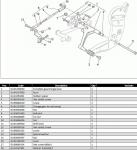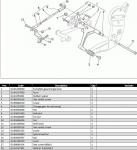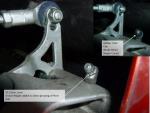-
Posts
988 -
Joined
-
Last visited
-
Days Won
43
Content Type
Profiles
Forums
Events
Gallery
Community Map
Everything posted by MartyNZ
-
If you don't have 35mm film handy, I've heard of someone making a seal scraper cut from a plastic water bottle. Or you could buy one of these: http://sealmate.net/ or http://www.riskracing.com/pages/Seal_Doctor_Page.html
-
Yesterday I loaded Meinolf's ECU .bin file #41 onto my bike. Meinolf has done a pretty good job developing that map. I did this preparation to the bike, mostly at Meinolf's recommendation: Step 1. Tighten loose clamp on RH cylinder intake hose, as I noticed black soot was marking the intake manifold stub. Snort at 2000 - 3000 still there, but much reduced. Step 2. Check valve clearances. Found inlets both at 0.20mm, and exhausts both at 0.25mm. Adjusted all valve clearances to 0.25mm. Valve lash noise increased a little, 2-3000 rpm snort not noticed on short run. Step 3. Check TPS is set between 0.150 & .157 volts, with RH throttle disconnected and butterfly fully closed. Found set at 0.155 volts, not adjusted. Approximately 1mm slop noticed in RH throttle butterfly shaft at bottom. A rebushing job for next winter. Step 4. Close both air bleed screws fully, instead of half a turn out, and set idle on LH throttle stop. Seems to idle just as well as before, 1100 when warm. Step 5. Synchronise throttles using manometer at 4000-5000 rpm. Slightly uneven synch at idle, probably due to air leaks in throttle body shafts. Runs well. Step 6. Set fuel trim to zero, from +15. No noticable difference. Step 7. Load Meinolf's super bin file #41, replacing titanium kit firmware. Awesome! It starts up to a stable idle without needing to touch the throttle. No need to wake the neighbors anymore. It seems smoother in the off idle transition to 2000, with no hesitation, and it feels like the power curve is flatter. I know that I wanted to believe that it would be better, so perhaps part of this is in my imagination but it seems more willing at all revs, and inspires greater confidence in low speed manoeuvres. I will give it a few more days, then I will try #42. I wish I had a dynamometer in my garage to quantify the differences. My bike Configuration, - Original airbox, with OEM paper filter and rubber intake snorkels. - The plastic velocity stacks are smoothed to remove moulding edges & bumps. - Original air intake temperature sensor inside the air box. - Original cylinder head oil temp sensor, but fitted into a brass pocket, MG part no. 30163301, packed with heat sink compound (thermally conductive paste). - Original headers without crossover in front of the engine. - Original crossover - Titanium mufflers. - ECU 15M without lambda sensor So thanks to Meinolf, I'm off to work with a smile on my face, and bin file #41 working it's magic. ***Edit 17Oct2016 Report after a week: I won't be going back to the previous Titanium ECU map I saved in case I needed to. Next step is to try Meinolf's super bin file #42. ***Edit 29Jan2017 #42 is even better. However it might be too rich, as a guy behind me said he could smell fuel, and the oil temp doesn't get above 80 degrees C. I'll see if reducing fuel trim gets it under control, or else I will have to start learning how to use Tuner-Pro.
-
OEM Part Name: Lens - Turn Signal / Indicator - Amber Moto Guzzi Part Number: GU02753700 Replacement Part Brand or Source: Moto Guzzi / Aprilia Part number or other identifier: GU06753700 Differences from OEM (if any): Grey/Smoke colour instead of amber. Other Compatible Vehicles: Moto Guzzi Griso Other Comments: May need Amber bulb to replace standard bulb. Website link for source: http://www.tlm.nl/en/parts/or https://www.motointernational.com/store
-
I was going to suggest a cracked baffle inside the crossover, same as JBBenson. Cracked sheet metal parts can make a fierce noise under vibration with the tiniest movement, and often you can't see the cause. You can only detect it when you prod, squeeze, or deform the part. FootGoose's rattle is a similar example of a weird noise that you can find by poking and prodding. To relieve your concern about whether you should run the engine any more, you could remove the sump oil drain plug and look for metal on the magnet. Lots of fur on the magnet could tell you that something is breaking up inside. By the way, that's a nice looking bike.
-
Electrical switches need different treatment than plugs and connectors. Exposure to oxygen and moisture are still the problem, but any protection product needs to be thin enough to quickly squeeze out of the way of moving contacts. I believe that Vaseline & DC4 are both too thick for switches which have light contact tension. That Radio Shack Electrical Contact Cleaner and Lubricant is one of the many excellent products that do a good job of cleaning and lubricating switches & potentiometers. However, the lubricant left behind gives short term protection in the exposed environment of motorbike handlebars. For my handlebar switches, I'm looking for something in between thin "Contact Cleaner and Lubricant" and thick Vaseline or DC4. Lubriplate makes a product for automotive switches. https://www.lubriplate.com/CMSPages/GetProduct.aspx?productid=36 Unfortunately they don't ship internationally so I haven't used it, but someone in USA who has a problem with their ignition switch, or handlebar switches, could try it.
-
Warning? not really its not the plate its the flywheel that fails and can take out the crankcases with it. http://www.v11lemans.com/forums/index.php?showtopic=16675 Ciao More on that topic, with an interesting picture here:http://www.v11lemans.com/forums/index.php?showtopic=19510&page=2&do=findComment&comment=211566Aluminium alloys do not have a fatigue limit like steel, so every power stroke leads the aluminum flywheel inexorably closer to eventually cracking. Then the cracks join hands. Then "pop". Or is it "grind grind clatter"? I don't know 'cause I have a two plate clutch.
-
https://www.dropbox.com/sh/mu5cfxfbctxy7h6/AADVIsSC_9VyqI8tP92SmqYFa?dl=0 https://drive.google.com/open?id=0BxnfKnNo4vVwb3lua1lHdjBjaE0 A couple of videos taken by my cellphone, so the sound is partly drowned out by wind noise, but you can compare my V11 Sport Naked with Titanium pipes to DD's underslung Shark Gill cool looking Supa Dupa thing. Thanks to DD for not changing the shape of my bike during the demos. If you can't view the two video snips by either of the two links above, and you want to see them, can you PM me and I'll try another method of posting.
-
I agree, toxic as it is, it is too good to strip off. I used it as a primer, so it is still there, just under another coat of paint. I fitted the shift extender today. It's better alright!That slot is a mystery to me too, it may allow that lever to fit different shift pedals on other models. I'm still going to fettle the gearbox shift mechanism as Lucky Phil suggested. I tried it out on a trip out past the black stump today. It was to visit Dangerous, give him some stuff, and look at his bike. Now that is an awesome looking and sounding exhaust system!
-
My Girlfriend said I should think about getting down on one knee and not skimp on the expense. So I took her advice. She’s gonna love this…
-
That's such an interesting interview. What an active mind for 93 years old (Carcano, not Docc). And so many achievements.
-
Hey Chuck, my lever arrived today. It looks awesome! Good job on the machining. And Lucky Phil too. Good job on the prototyping. Now I just need to paint it so I can install it this weekend. Following Scud's idea, I'll paint it so it blends in with the gearbox & stuff in the background. Scud said once: "the driver for most of my cosmetic changes to the bikes is to cut down the visual clutter and focus on the large, elemental shapes that I like." Now I'm looking for a paint colour called "road grime splatter".
-
DC-4 is approved in Airbus Consumable Materials List as 03JAB1, and in Boeing Qualified Products List as D00254. See manual extracts in attachmentIt has been on the market for 70 years, so I expect that Dow's patent has expired. Motocraft electrical grease, and "bulb grease" could be the same stuff. The bad thing about this, and any silicon product, is that it makes painting difficult. It won't harm paint, but if it gets on something you want to paint in the future, then it will need special attention to cleaning. It repels paint spray just like it repels water. DC-4 Dielectric Grease.pdf
-
I agree that opening, cleaning and sealing electrical connections is a good way to improve reliability. Poor connections are most often caused by moisture and/or oxygen forming an electrically insulating layer (tarnish or corrosion) in the joint. Vaseline does a good job of excluding both water and oxygen from a plug or terminal.I used Dow Corning Compound 4, as it is specifically designed for this application, so I thought it would be even better than vaseline. Dow says this about DC4: "A moisture proof seal for aircraft, automotive and marine ignition systems and spark plug connections, disconnection junctions in electrical wiring systems also in electrical assemblies and terminals". I cleaned all the connectors on my bike, then filled them so full of DC4 that it oozed out as the connectors were plugged. Same with relay bases & lamp sockets. However, DC4 is a silicon based dielectic grease. It is also non-conductive, but squeezes out to allow metal to metal pin & socket contact. Have I made a mistake? If Gstallons, Wayne Orwig, and Kiwi_Roy think silicon is bad, should I clean it out of the connectors? https://www.google.co.nz/url?sa=t&source=web&rct=j&url=http://www.farnell.com/datasheets/319850.pdf&ved=0ahUKEwjvgq3T1YXPAhXFKZQKHXU4DW4QFggfMAI&usg=AFQjCNHauFpF8tXzI_HDDEzfDusfYwoyug https://www.amazon.com/gp/aw/d/B0195UWAHG/ref=mp_s_a_1_3?ie=UTF8&qid=1473581534&sr=8-3&pi=SX200_QL40&keywords=dc4&dpPl=1&dpID=4197U0ONekL&ref=plSrch
-
There are some good pics posted by BelfastGuzzi here http://www.v11lemans.com/forums/index.php?showtopic=16872&st=0While you have the side plate off, why not look at Lucky Phil's improvements http://www.v11lemans.com/forums/index.php?showtopic=19547 This spring seems to have a short life. I see that you posted a question about this in 2014. http://www.v11lemans.com/forums/index.php?showtopic=18737&hl=spring Can I have your old broken spring? I'm going to try to make a different spring arrangement that will last longer. Maybe a pair of lighter springs, or an extra turn on a spring made of similar wire, or use better material. Marty
-
I didn't know that there is 7 Guzzis in NZ, let alone with one guy in the South Island.
-
Nice! A Sonerai with an air cooled VW engine. It's got something in common with the V11. And you have the aviation version of a personalized plate. Cool.
-
We know that you got the idea, trialed it, and then told everyone. Well done you too!It wouldn't have happened without your efforts.
-
I know what you mean. Some metals are hard work. I just finished making attachment brackets for the new bike rack I should have fitted 6 months ago. I had a brainwave and pulled some titanium out of a scrap bin, thinking that it would match the titanium cans. What a dumb idea! I couldn't cut it, so made up a .dxf file and went to the closest laser cutter. They said "nope, 4mm thick is the limit for that stuff without argon, and we use nitrogen". Then the water cutter said "8mm? Sure, come back tomorrow with $90". That's when the fun started. I wrecked 4 drill bits and 2 taps, but at least it didn't catch fire. Then I painted the brackets black, so the idea of matching the cans was wasted. Next time I think that Ti6Al4V is a good idea for something, I'll have a beer until I calm down. I believe that the Russians make a lot of titanium stuff, which helps explain why they drink a lot of vodka.
-
I can download the BIN file from my Ti ECU this evening and send it to you if you PM me with an email address. Note that my ECU has 02 written on it. There is more than one version of the Ti ECU. You should consider Docc's advice though.
-
On my bike, the bush protrudes from the foot pedal lever (item 1), and just fits into the hole in the pushrod drive lever (16). That lever (16), that Chuck is making, has the rear lower hole the same size as the bush (2) OD, not the pivot bolt (5) OD. At least that's what I'm expecting when the slow boat from California arrives, and that's what Chuck's CAD drawing seems to show. And Chuck's picture in post #18 of this topic.I made new bushes (2) for my Pedal Lever, and I expected to be able to drive them further in, as Docc suggested, and trim them off later, but no. The counterbore for the outboard bush was about 10mm for a 10mm long bush. At the inboard side, the counterbore was about 8mm for the 10mm bush. The bush on that side is designed to protrude, but not enough to touch the subframe tab.
-
I agree Tim. On my shift lever, the bush (item 2 in the picture) protruded out of the inner face, but is flush on the outer face.
-
The previous owner of my bike added a grease nipple to the shift lever. I thought that this was a good idea for others to do at the same time as fitting the extended lever, so posted this picture. Also, I had slop on the inner bush of my shift lever, where I found that the pivot bolt was threaded too much, so the inner bush sat on threads instead of plain shank. The bush had grooves worn in it, and the threads were worn flat. I got a new bolt with less thread on it, and made new bushes. This improved shift lever action a little.
-
I'm keen to buy one too. And if there is any other interest from NZ, I can act as your distributor if that suits you.
-
To add to Docc's wisdom, Penrite, my current favorite oil manufacturer, has this helpful writeup about zinc / ZDDP / dialkyldithiophosphate additive in oil. They begin by saying: "There is a lot of hysteria over zinc levels in oils, especially in the latest specification engine oils. Many of these myths and stories are unfounded. To understand more read the latest up to date information here:" http://www.penriteoil.com.au/tech_pdfs/0Zinc%20Myths%20&%20Legends%20Nov%202014.pdf I see that they talk about phosphorus at the same time as zinc. This comes from zinc-dialkyldithiophosphate burning when it gets past the rings or valves. Freed phosphorus can poison the catalytic converter if one is fitted.









